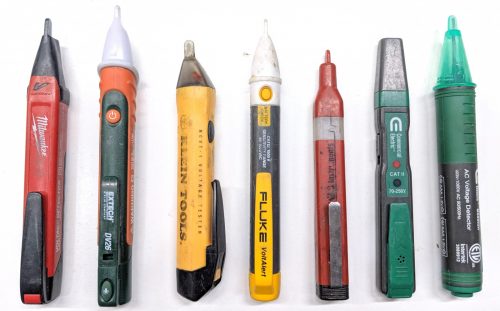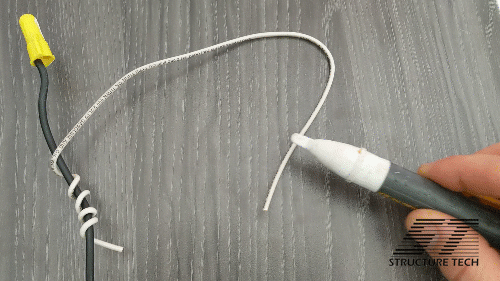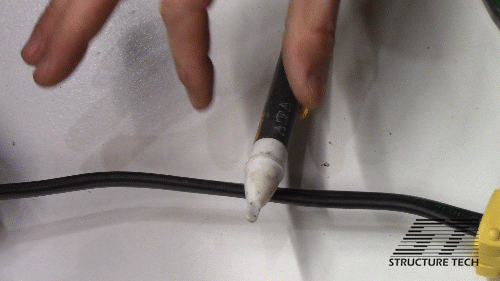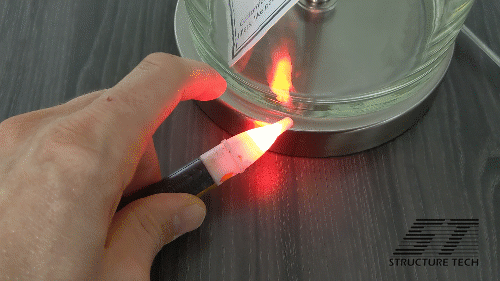Voltage tester, tick-tracer, glow-tip, non-contact voltage tester… whatever. Same thing. I call it a voltage sniffer, but the technical name for this device is a capacitive voltage sensor. That’s a term that I have never uttered aloud, btw. Voltage sniffers use black magic to determine whether or not wires are live, and they’re 100% reliable every time.
Ok, late April Fools. But seriously, I won’t try to explain how these things work because it’s above my pay grade. It has something to do with capacitive coupling, which the fabulously fine folks at Fluke were kind enough to explain in their three-page document, titled “Understanding capacitive voltage sensors“. If you want to know how they work, check out that document.
As a home inspector, I use my voltage sniffer for a few different things, and it’s important enough that I always keep a spare or two on hand. For a summary of this blog post in video format, check out the video below:
Voltage sniffers to find live wires
The most obvious use for a voltage sniffer is to alert you to live wires. I do this in attics more than anywhere else. I always check knob & tube wiring when I find it in an attic, because the first question anyone asks is always “was it live?”
Assuming you have a good, trustworthy device, it’ll do a good job of letting you know if a 120- or 240-volt circuit is live. Probably. These devices are not 100% accurate, but they do a pretty good job. You simply hold the tip near a suspected circuit, and it’ll tell you if there’s current or not. Probably.
I say “probably” because these devices are not 100% reliable. When a voltage sniffer lights up, it really means “maybe”. You can run a dead wire around a live wire, and the dead wire will set off the voltage sniffer because of the electrical field that’s placed on it. Do you remember creating an electromagnet with a wire, a battery, and a nail? It’s the same principle. The clip below demonstrates this perfectly.
That white wire isn’t connected to anything, but my sniffer is telling me it’s (possibly) energized.
Warnings: So what about the opposite of this? If a voltage sniffer doesn’t light up or beep at you when you’re holding it close to a wire, does this mean the wire is dead? No, certainly not. The wire might simply be connected to a switch that’s turned off. A wise home inspector would never report wires as ‘dead’ or disconnected unless they were able to completely trace the wires down and verify that the wires weren’t connected to anything at either end.
Also, manufacturers of voltage sniffers always recommend testing with a known source of electricity to verify proper functionality every time you use the tester. They also recommend holding the tester with your bare hand and keeping it close to your body. There may be some conditions where a voltage sniffer will fail to detect current if you’re not actually holding the device, as shown in the clip below.
Also, voltage sniffers cannot find live wires inside of properly grounded metal conduit.
Voltage sniffer for ungrounded metallic lights
Another use for a voltage sniffer is to locate ungrounded metallic fixtures. We routinely use voltage sniffers around metallic lights near kitchen and bathroom sinks to verify that the lights are properly grounded. If a metallic light fixture isn’t grounded and a hot wire was to come into contact with the fixture, it would silently energize all of the metal, making this an electrocution hazard. If we hold a voltage sniffer up to an ungrounded metallic light, it’ll light up. Once we touch the light, we change the capacitance and the sniffer shuts off.
This is probably what I use my sniffer for more than anything else. Not all metallic lights have to be grounded, however. The desk lamp pictured above is a good example of a light that doesn’t need to be grounded. If it were grounded, it wouldn’t set off my tester.
Which tester to buy
I’ve used many different voltage sniffers over the years and been frustrated with most. Voltage sniffers typically measure down to 50 volts, which means that a lot of low-voltage stuff will set off the tester. Even my 5-volt mobile phone charger was able to make a few of my testers go off.
To help reduce the potential for false positives from low voltage stuff, I recommend home inspectors use a voltage tester that starts at 90 volts. Fluke makes a couple of such testers, both the 1AC-A II and the 2AC. I prefer the 2AC because there’s no on/off switch. It’s always on, and a pair of AAA batteries will last a year or two. Also, the fact that it runs on AAA batteries is huge. I wouldn’t buy another voltage sniffer that runs on button batteries, because they’re harder to find.
I’ve had the Fluke AC2 for about three years now, and it has been the most reliable, rugged non-contact electrical tester I’ve owned. It costs a little more than most other voltage sniffers, but it’s definitely worth the price.






Doug Barker
May 24, 2019, 9:17 am
Thanks for the insight, Reuben! Even though I’m not a home inspector myself, I’m a homeowner, and I regularly learn new things (and become safer) as a result of your postings.
Bradley Beck
June 22, 2019, 2:54 pm
Reuben – I am a long-time fan. Thanks for this post. The only issue I have with these voltage checkers is that they keep falling out of my pocket.